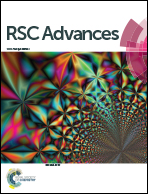Stability-indicating chromatographic determination of hydroquinone in combination with tretinoin and fluocinolone acetonide in pharmaceutical formulations with a photodegradation kinetic study†
Abstract
Two sensitive and selective stability-indicating methods were developed for simultaneous determination of the active pharmaceutical ingredient hydroquinone in combination with tretinoin and fluocinolone acetonide in their pure forms and within the pharmaceutical formulation. Method A was based on a gradient elution liquid chromatographic (HPLC) determination of the active ingredients, their degradation products (hydroquinone polymer, 1,4-benzoquinone, isotretinoin and fluocinolone acetonide photodegradation) and in the presence of the preservatives methyl and propyl parabens found in pharmaceutical formulations. Method B was a thin layer chromatography (TLC)-densitometry method using a chiral developing system for the separation and determination of the active ingredients, isotretinoin, the preservatives and 1,4-benzoquinone. The molecular weight of the hydroquinone polymer formed from its alkali degradation was characterized by gel permeation chromatography. The mechanism of fluocinolone acetonide photodegradation in acetonitrile at 254 nm was studied using single crystal X-ray diffraction. The degradation products, hydroquinone polymer and isotretinoin, were found in one batch of the pharmaceutical formulation analyzed near its expiry date. The proposed HPLC method was also used for a comparative kinetic study of the photodegradation of the active ingredients. Hydroquinone showed reversible zero order kinetics, tretinoin and fluocinolone acetonide followed complex kinetic reactions in acetonitrile within two hours. The results obtained were statistically analyzed and compared with those obtained by applying the manufacturers method.


 Please wait while we load your content...
Please wait while we load your content...